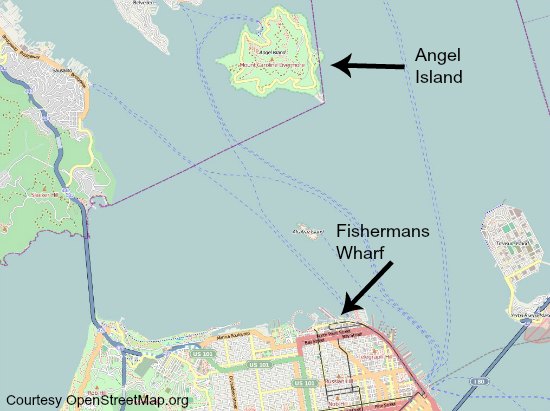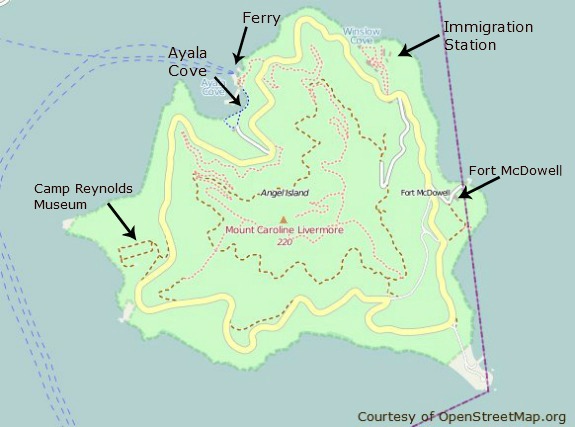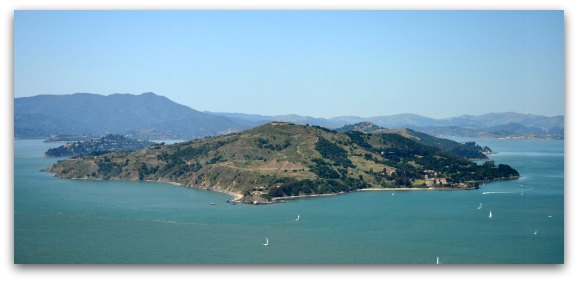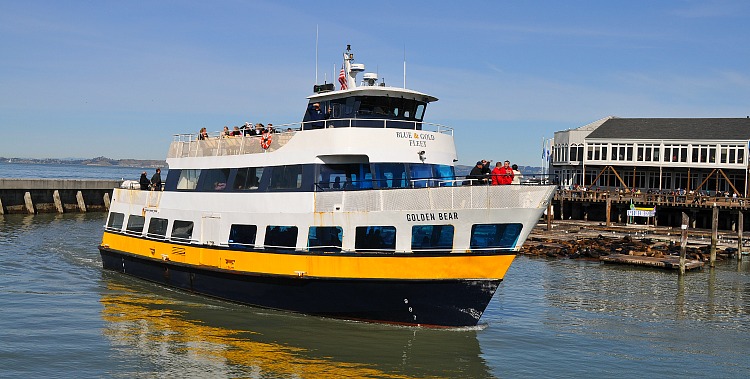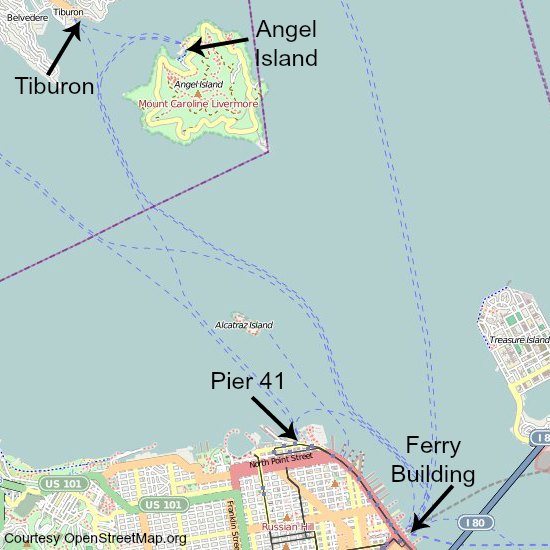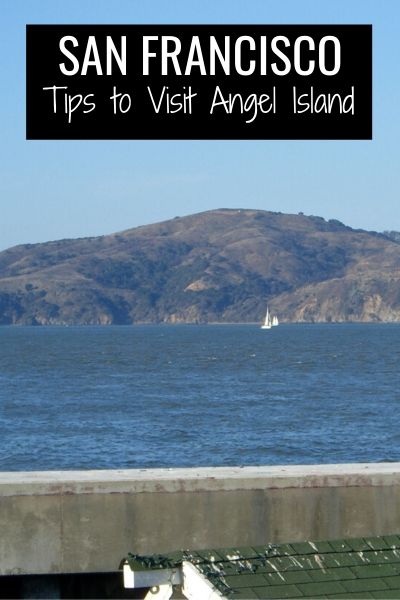SIGN UP FOR MY EMAIL TO RECEIVE YOUR FREE SAN FRANCISCO PLANNING GUIDE.
Angel Island San Francisco: History & Visiting Tips
By: Jill Loeffler • Updated: January 13, 2025 • Published: November 21, 2011
Angel Island San Francisco is the largest island in the SF Bay, slightly northeast of Alcatraz. Although it's a quiet California State Park today, this site has played an important role in US history.
You'll find Angel Island just over a mile off the shores of Fisherman's Wharf.
The only way to get to and from there is by taking one of the ferry rides or your own boat.
I recently updated the latest ferry schedule, which starts on January 13, 2025.
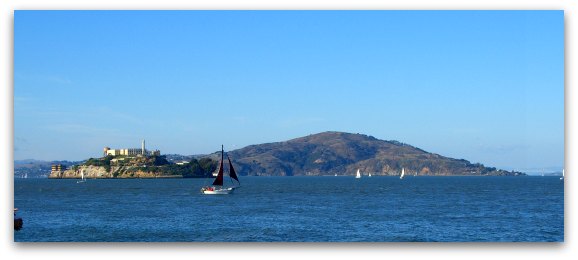 Here is a view of it from Fisherman's Wharf. It's the larger
one on the right side. The smaller one on the left is Alcatraz Island.
Here is a view of it from Fisherman's Wharf. It's the larger
one on the right side. The smaller one on the left is Alcatraz Island.Angel Island is an easy day trip and a great way to spend some time outdoors away from the hustle and bustle of the city.
Hiking, biking, and photography are its three key activities as you visit some of the historical buildings.
- History of the Island
- Map of Angel Island
- Historic Buildings
- Hiking, Biking, & Other Activities
- Tips to Prepare
- Ferry Details
Here is a map showing the island's location within the SF Bay.
Angel Island History
For thousands of years, Angel Island San Francisco was used by local indigenous people for fishing and hunting.
In 1863, the federal government sought more land in the San Francisco Bay and took control of it, turning it into a US Army base called Camp Reynolds during the remainder of the Civil War and for a few years after.
In 1910, at the height of the Chinese Exclusion Act, Angel Island San Francisco became a detention center for unwanted immigrants arriving to the US through San Francisco.
Almost all immigrants who crossed the Pacific from China ended up here first, some staying for months or even years while trying to become US citizens. While here, they faced tough questioning before entry was granted.
After the main immigration building burned down in 1940, the military reclaimed Angel Island during World War II and used it to detain many prisoners of war, specifically those from Japan and Germany. When the war ended, it remained vacant for a while.
In 1963, the State of California declared Angel Island San Francisco a state park and that is still its purpose today.
Angel Island Map
Get acquainted with the island's layout before your trip. In the map below I've labeled the key areas to visit, and in the sections below that, you'll find details about what there is to do at each location.
Historic Buildings
For a long time, no one realized the importance of the buildings that remained from Angel Island's past as an immigration station.
The state had scheduled their demolition in the 1970s, but luckily a park ranger noticed the poems that had been carved into the wooden walls from detainees in Chinese, Russian, Japanese, and other South Asian languages.
Thus, the state decided to keep the buildings, which now comprise the centerpiece of this National Historic Landmark.
There are four main buildings that house small Angel Island San Francisco history museums.
Visitors Center Museum on Ayala Cove
The minute you step off the ferry, you encounter the first museum located in the Visitors Center, which is actually the old officers' quarters. The tours are self-guided and there are two free films playing throughout the day.
One is on the history and natural habitat of the island; the other is about its history as an immigration station. Both are around 20 minutes long.
Detention Barracks Museum & WWII Mess Hall
From the Visitors Center, you can either walk or take a shuttle to this museum 1.5 miles east of Ayala Cove. Here, you'll find information about the site's history with immigrant detention, interrogation, and exclusion.
Both self-guided and docent-led tours are available and tickets are required to enter. Prior online reservations for guided tours are highly recommended, as drop-in tours are only available if volunteers are available.
Stop by the Cove Cafe on the island for more information on the tours offered the day of your trip.
Angel Island Immigration Museum (AIIM)
Located in the site's old hospital building, this museum contains three permanent exhibits designed to give a more complete history of the immigration legacy on the island.
The 'In the Shadows' and 'Opening Doors' exhibits draw connections between immigration—and immigrants—then and now. 'Under the Microscope' examines the building's former use as a hospital.
There is no entry fee for this museum.
Additional Historic Military Sites
Camp Reynolds is a Civil War site on the west side of the island where visitors are free to explore the grounds. When volunteers are available, they open the Bake House and Quarters 10.
Fort McDowell is a WWI and WWII site on the east side of the island, whose grounds are also open for visitors to explore. When volunteers are available, the Chapel and Guard House Museum are open for tours.
Check in at the Visitors Center to find out what's open on the day of your visit.
More Fun San Francisco Activities
Outdoor Activities
Most people head over to Angel Island San Francisco for hiking, biking, and other outdoor fun, since it is such a beautiful place to spend the day.
Hiking, Biking & Photography
Angel Island offers more than 13 miles of trails, 8 of which allow bikes. Whether you decide to hike or bike, you'll find lots of photo opportunities along the way.
To get to the highest peak, Mount Livermore, you'll climb 788 feet, about a 2.5-hour, 5-mile round trip hike from the ferry drop off point.
From the top, you'll get some amazing views of the bay's treasures. Alcatraz Island is just off to the west of the island, so you get a unique look at it from this angle. You can also get a great shot of San Francisco and the Golden Gate Bridge.
Baseball & Volleyball
If team sports is your plan, then you will find both a baseball diamond and two volleyball courts.
The baseball field is an old field used by soldiers when Angel Island San Francisco was a military base, open for use on a first come, first served basis.
There are two places to play volleyball. The first is near Ayala Cove and reservations are required, so call ahead for availability before heading over. The second court at Ft. McDowell is open, but the park does not guarantee availability of these courts.
Camping on Angel Island
Angel Island San Francisco allows overnight camping. There are ten camping sites and reservations are required.
You can choose from the sites available. The four environmental camping areas include the East Bay Sites, where you're a little more sheltered from the wind, the Ridge Sites, which are more exposed but offer views of the Golden Gate Bridge and San Francisco, the Sunrise Sites, and the Kayak Sites by a small beach.
Reserve online to get your spot. There is limited space, so reserve early. You can reserve as far as 6 months ahead of your planned trip.
Be prepared to hike up to 2.5 miles to your campsite carrying your gear. Bring along some warm clothes, as the bay is windy and chilly at night.
Tours
Tram tour: The easiest tour option is an hour-long open-air educational tram ride, which picks up at Ayala Cove and drives along the flat fire road that circles the entire island. Do not confuse this with the shuttle ride directly over to the Immigration Station, which takes about 10 minutes.
You can, however, get off the tram at the Immigration Station, the last stop on the tour, to explore on your own and then either walk back to the ferry dock or wait for the shuttle.
The tours run a couple of times a day, at 11:45 am and 1:45 pm. Tour capacity for the tram is 50 people, so you could book in advance online, but usually you can also purchase same-day tickets at the cafe. Tickets are $18 for adults, $17 for seniors 65+, and $12 for children ages 5 to 12.
Shuttle: The roundtrip shuttle ride to the Immigration Station is $10 per guest. It departs at 10:30 am from the ferry dock and picks up from the Immigration Station at 12:45 and 3:00 pm. Additional times may be added based on visitor numbers.
Bike rentals (self-guided): Additionally, you can rent bikes on the island to take in the bay views and access some of the farther away spots in less time. Mountain bikes are available starting at $16 by the hour or for the full day. E-bikes are also available starting at $26 to guests 18+ to make getting up some of those hills a little easier.
Detention Barracks Museum & WWII Mess Hall: The guided tour of this museum is $7 for adults, $5 for youth, and $3 for children 4 and under. Prior online reservations for guided tours are highly recommended. Without the guided tour, admission is $5 for adults, $3 for youth 5-17, and free for children 4 and under.
This is separate from the Angel Island Immigration Museum, which is free.
Hours
Both the Angel Island Immigration Museum and the Detention Barracks Museum & WWII Mess Hall are open during the following hours:
- Wednesday - Friday 11 am - 2:30 pm
- Saturday - Sunday 11 am - 3:30 pm
These hours are subject to change, especially if ferry schedules change.
Please check ferry times for the Golden Gate Ferry and the Angel Island-Tiburon Ferry. For private boaters, the island is open until sunset.
Eat & Drink
Angel Island San Francisco is also a great place for a picnic. You can choose from a larger site for a big group picnic or one of the many smaller picnic sites for a more intimate lunch. The larger sites take reservations.
You can also grab a quick snack and a drink—especially refreshing after a long day of hiking or biking—at the Angel Island Cafe.
Note: As of January 2025, this cafe's kitchen and gift shop is still closed closed for construction. They still sell snacks, drinks, and cold meals (sandwiches and salads), but no made-to-order or hot food.
Restrooms
Facilities are limited on the island.
You will find restrooms at Ayala Cove by the ferry dock and main picnic area, as well as near the museums at Camp Reynolds, the Immigration Station, and Ft. McDowell.
There are also pit toilets at all campsites.
Tips to Prepare for Your Visit
Visiting requires some planning, since there are only a few ferries back and forth during the day.
The ferry ride is a little chilly most days, so you'll want to bring plenty of layers to stay warm, especially because the weather on the island can be unpredictable as well.
Angel Island's climate is similar to San Francisco's, in that it can be nice and cool one day, warm the next, and really windy the following day. Check out the San Francisco weather page to prepare for the day you plan on visiting.
For the hiking trails, bring along comfortable shoes, water, and, snacks for your day. You can also stop at the cafe before or after your hike.
The biking trails are mostly easy with a few steep areas. You should bring along food, water, and a jacket to stay warm when you stop to take pictures.
If you decide to camp overnight, prepare for a cool and windy night as there is not much blocking the wind off the bay. Most nights are between 45 and 55 degrees.
In September and October, it is a little warmer with lows in the upper 50s to lower 60s. It rarely gets below the 40s on the island.
SFTourismTips is made possible by readers like you! If you book through my links, I may earn a small commission—at no extra cost to you. Thanks for your support! Learn more.
Angel Island Ferry Information
Their are two ferry companies that get you to and from Angel Island in the SF Bay, offering service a few times a day.
The Golden Gate Transit ferry is the only one that runs the between the island and San Francisco city.
The Angel Island-Tiburon Ferry, on the other hand, takes you to the island from the quaint town of Tiburon on the northern side of the Golden Gate Bridge.
Tips for Booking Tickets and Taking the Ferry to Angel Island
You can either purchase your tickets online or in person at the pier. The time of departure on the ticket is the time the boat pulls away from the dock. I recommend you get there at least 15 minutes in advance—or even earlier—to make sure you get on the boat before the doors close.
Bring along some warm layers for the ride. It can get a little chilly most days and sitting outside is the best way to see all of the sites along the way.
If you are planning on biking on Angel Island San Francisco, you may bring your bike on the ferry and park it on the first level, where you'll see the rest of the bikes.
Both ferries alter their schedules for major holidays such as Christmas and New Years Day. Always check the schedule before booking your tickets.
Maps for the Ferries to Angel Island
In the map below, you'll see the ferry terminals in San Francisco, Tiburon, and the drop-off dock on Angel Island.
Golden Gate Ferry from San Francisco
Golden Gate Ferry now runs the ferries to Angel Island from San Francisco. The cost is $31 per roundtrip ticket for an adult ages 19 to 64 (or $19 with Clipper).
Seniors ages 65 and up, children ages 5 to 18, and people with disabilities are $16 roundtrip. Children under the age of 4 are free (limit two per full-fare adult).
It's important to buy roundtrip tickets, as return tickets are not sold on Angel Island.
They currently run just a handful ferries a day back and forth from the island. Make sure to pay attention to the time so you don't miss the last ferry back.
Here is their current daily schedule for Monday through Friday. Also make sure to check the boards so you know if they have a change for the day you visit.
Leaves from the
|
Arrives
|
Leaves
|
Arrives at the
|
Golden Gate Ferry Weekend and Holiday Schedule
You will find four ferries on the weekends and holidays.
Leaves from the
|
Arrives at
|
Leaves
|
Arrives at the
|
Angel Island-Tiburon Ferry from Tiburon
The Angel Island-Tiburon Ferry is a separate company that runs from Tiburon and does not have a stop in San Francisco. This ferry ride is much shorter than the one from San Francisco, but you'd have to get to this bayside town north of San Francisco first.
During the summer months, these ferries run daily, but from September to May, they run only Wednesday through Sunday.
Roundtrip tickets are $18 for adults, $16 for seniors 65+, $15 for children 6-12, and $6 for children 3-5. Riding with your bike is an extra $1.
Visit the ferry website for a full schedule as it can change and it's good to book ahead.
Other Pages You Might Enjoy
If you are intrigued by Angel Island, you might be interested in my pages about other significant historical and cultural places to visit while in SF.
Alcatraz: If this is your first visit to San Francisco, a trip to Alcatraz is a must! This amazing attraction is another island in the SF Bay just a mile from the shores of the city. Discover some of the great tours available to see this infamous former prison.
SF Districts: Not sure where to start planning your trip? Here you will find the best activities by district.
Museums: San Francisco offers more than 70 museum experiences of all types. Check out the top 20 art, science, history, and other museums and learn about the details for visiting.

Hi, I'm Jill!
Dreaming of a San Francisco vacation? As a proud local, I'm here to share my insider tips and personal experiences to help you make the most of this iconic city!
Comments? Questions? Suggestions?
I would love for you to join me in my private Facebook group!
It's a great place to interact with me and others who know the area well.
You can ask questions, get advice for your upcoming stay, and then share your photos and advice with others when you return home. It's a great community and the fastest way to get answers to those nagging questions about your visit!
